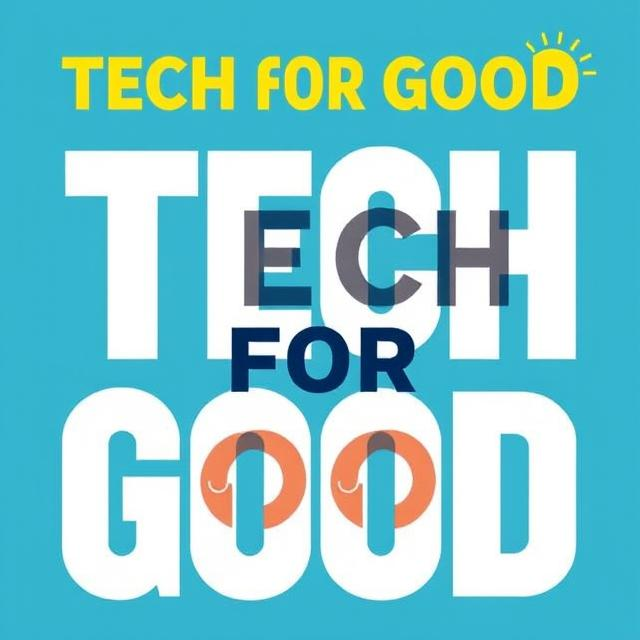Introduction
In an increasingly interconnected world, technology has become a powerful force for addressing global challenges. From climate change and poverty to health crises and access to education, innovations in technology are being harnessed to tackle some of humanity’s most pressing issues. While the rapid advancement of technology often brings concerns about its impact, the reality is that “tech for good” is playing an integral role in solving problems and driving positive change. This article explores how technology is being used to tackle global challenges and the ways in which it is shaping a more sustainable, equitable, and resilient future.

1. Tackling Climate Change with Technology
Climate change is one of the most significant challenges of our time. The effects of rising temperatures, extreme weather events, and environmental degradation are felt globally. Technology is playing a crucial role in mitigating climate change and creating solutions for a sustainable future.
Renewable Energy Innovations
Advancements in renewable energy technologies, such as solar, wind, and geothermal, are reducing our reliance on fossil fuels. Solar power, in particular, has seen tremendous progress, with solar panels becoming more efficient, affordable, and accessible. Companies like Tesla are leading the way in solar energy and energy storage, enabling homes and businesses to generate and store clean energy.
What does this mean? By transitioning to renewable energy sources, technology is helping reduce carbon emissions, mitigate the effects of climate change, and move toward a sustainable energy future.
Carbon Capture and Storage (CCS)
Technologies that capture and store carbon dioxide emissions from industrial processes are helping reduce greenhouse gas concentrations in the atmosphere. CCS technologies, such as direct air capture, are being developed to remove CO2 from the air and store it underground, slowing the pace of global warming.
What does this mean? CCS offers a potential solution to significantly reduce global emissions and help meet international climate goals, such as those outlined in the Paris Agreement.
Smart Agriculture
Agriculture is a significant contributor to greenhouse gas emissions, but technology is helping farmers grow crops more efficiently and sustainably. Precision farming techniques, powered by IoT sensors, GPS, and AI, allow farmers to optimize water use, monitor soil health, and reduce pesticide use, leading to more sustainable farming practices.
What does this mean? Through smart agriculture, technology is helping to increase food security, reduce environmental impact, and improve productivity in the face of climate challenges.
2. Improving Healthcare with Technological Advancements
Access to quality healthcare is a global issue, especially in low-income regions where medical infrastructure is lacking. Technology is stepping in to provide innovative solutions to improve healthcare delivery, diagnosis, and treatment.
Telemedicine and Remote Healthcare
Telemedicine has become a vital tool in overcoming geographical barriers to healthcare access. Platforms like Teladoc and Doctor on Demand are enabling patients to consult with healthcare professionals via video calls, reducing the need for travel and making healthcare services more accessible to remote and underserved populations.
What does this mean? Telemedicine is revolutionizing healthcare access, particularly in rural and low-income areas, improving health outcomes and reducing the strain on traditional healthcare systems.
AI in Diagnostics and Treatment
Artificial Intelligence (AI) is transforming the healthcare industry by improving the accuracy of diagnostics, personalizing treatments, and predicting health risks. AI algorithms are being used to analyze medical imaging, such as X-rays and MRIs, to identify diseases like cancer at earlier stages. Additionally, AI-powered platforms like IBM Watson Health are being used to assist doctors in decision-making and recommending treatment plans based on vast medical data.
What does this mean? AI is enabling faster, more accurate diagnoses and more personalized treatments, improving patient outcomes and helping to reduce healthcare disparities.
Wearable Health Tech
Wearable devices, such as smartwatches and fitness trackers, are providing real-time health monitoring, enabling individuals to track their heart rate, sleep patterns, and physical activity. More advanced wearables, like Fitbit and Apple Watch, offer features like ECG monitoring and blood oxygen level tracking, providing crucial data that can help detect potential health issues early.
What does this mean? Wearable technology empowers individuals to take control of their health and enables early detection of potential health issues, reducing the burden on healthcare systems.
3. Reducing Poverty and Improving Access to Education
Technology is also playing a key role in reducing poverty and providing equitable access to education, which is fundamental to breaking the cycle of poverty. In many parts of the world, access to education and resources remains limited, but tech-based solutions are making learning more accessible and effective.
Online Education and E-Learning Platforms
The rise of e-learning platforms like Coursera, Khan Academy, and Udemy is democratizing education by offering online courses on a variety of subjects for free or at affordable rates. These platforms are particularly beneficial in developing countries where traditional education systems may be underfunded or inaccessible.
What does this mean? E-learning is empowering individuals to gain knowledge and skills, increasing educational opportunities for people worldwide and helping to bridge the global education gap.
Mobile Learning for Remote Areas
In many developing regions, access to the internet is limited, but mobile phones are widely used. Mobile-based educational applications and resources, such as M-Learning, are enabling students in remote areas to access learning materials through their phones. Initiatives like Google’s Loon project aim to provide internet connectivity in underserved areas through high-altitude balloons, further enhancing access to educational resources.
What does this mean? Mobile learning is improving educational access in remote and underserved areas, helping to break down geographical barriers and provide knowledge to those who need it most.
Microloans and Digital Financial Services
Technology has made financial services more accessible to people in developing countries through platforms like M-Pesa and PayPal. These mobile-based services allow individuals without access to traditional banking to send money, receive payments, and even access microloans. This has opened up opportunities for entrepreneurship and economic mobility in previously underserved communities.
What does this mean? Digital financial services are providing underserved populations with the tools they need to participate in the economy, reduce poverty, and improve their quality of life.
4. Enhancing Disaster Response and Crisis Management
In the face of natural disasters, humanitarian crises, or pandemics, technology has been instrumental in providing faster, more efficient responses, saving lives, and minimizing damage.
Disaster Management Technologies
AR and VR are being used to train emergency responders, simulate disaster scenarios, and prepare for real-world emergencies. Additionally, AI and big data are used to predict natural disasters, such as hurricanes or earthquakes, providing early warnings and helping to evacuate vulnerable populations in time.
What does this mean? By improving disaster prediction and response, technology is helping mitigate the impact of natural disasters and saving lives during crises.
Drones for Disaster Relief
Drones are being increasingly used in disaster relief efforts to deliver aid to hard-to-reach areas, assess damage, and provide real-time data to responders. Drones can survey disaster-stricken areas quickly, providing valuable information for effective decision-making during emergencies.
What does this mean? Drones are revolutionizing disaster relief by enabling faster, more efficient deliveries of aid and helping responders assess and manage crisis situations with greater precision.
5. The Role of Technology in Promoting Sustainability
Sustainability is a key area where technology is driving positive change. From eco-friendly innovations to more efficient resource management, technology is helping individuals, organizations, and governments minimize their environmental footprint.
Sustainable Manufacturing and Circular Economy
Technology is enabling more sustainable manufacturing processes that reduce waste, optimize resource use, and recycle materials. Innovations like 3D printing allow for on-demand production, reducing the need for mass manufacturing and waste.
What does this mean? Through sustainable manufacturing practices, technology is helping reduce the environmental impact of production, promoting a circular economy where materials are reused, and waste is minimized.
Smart Cities and Resource Management
In smart cities, technology is being used to optimize the use of resources such as water, energy, and transportation. IoT sensors, AI, and big data are helping cities manage traffic, reduce energy consumption, monitor air quality, and optimize waste management.
What does this mean? Smart cities are improving sustainability by using technology to optimize urban resource use, reduce pollution, and enhance the quality of life for urban residents.
FAQs About Tech for Good
Q1: How is technology helping in the fight against climate change?
Technology is aiding the fight against climate change through innovations in renewable energy, carbon capture, smart agriculture, and waste management, all of which help reduce greenhouse gas emissions and promote sustainability.
Q2: What role does technology play in global healthcare?
Technology in healthcare includes telemedicine, AI for diagnostics, wearable health devices, and digital health platforms, all of which improve access to care, reduce health disparities, and enhance patient outcomes.
Q3: How is technology reducing poverty?
Tech solutions like mobile banking, microloans, and e-learning platforms are enabling economic participation and providing access to resources and education, reducing poverty and promoting economic mobility.
Q4: Can technology help in disaster relief efforts?
Yes, drones, AI, and real-time data analytics are being used to assess damage, deliver aid, and manage disaster relief efforts more efficiently, saving lives and minimizing the impact of natural disasters.
Conclusion
Technology has proven to be a powerful tool for solving some of the world’s most pressing challenges. From climate change and healthcare to education, poverty, and disaster response, tech innovations are playing a pivotal role in driving positive change. As technology continues to evolve, its potential to solve global challenges will only increase, making it an indispensable force for good. By continuing to harness technology for social impact, we can create a more sustainable, equitable, and resilient world for future generations.
